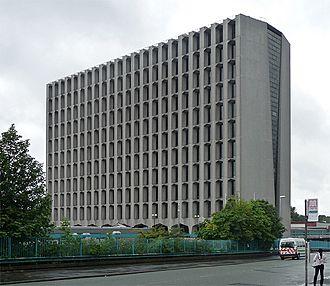Hexagon Tower facts for kids
Quick facts for kids Hexagon Tower |
|
|---|---|

A picture of the Hexagon Building in Manchester
|
|
| Former names | Hexagon House |
| General information | |
| Type | Chemical Research Centre |
| Address | Manchester |
| Coordinates | 53°31′20″N 2°13′33″W / 53.5221°N 2.22577°W |
| Elevation | 90 m (295 ft) |
| Client | ICI Dyestuffs |
Hexagon Tower is a special building in Blackley, North Manchester, UK. It's a place where scientists and technologists work on new ideas. This building used to be a big research center for a company called Imperial Chemical Industries (ICI).
The site where Hexagon Tower stands has been used for science and industry since 1785. Today, it's part of a network of science parks called BEST. This network helps different science companies grow and work together.
Contents
The Story of Hexagon Tower
Early Beginnings: Dyes and Discoveries
The land where Hexagon Tower is built has a very old industrial past. The first business there was the Borelle Dyeworks. It was started in 1785 by Louis Borelle, who came from France. He made a special red dye called 'Turkey Red'.
Later, another French person, Angel Raphael Louis Delaunay, took over the dyeworks. He started his own dyeing business in the early 1800s.
In 1865, a German scientist and businessman named Ivan Levinstein bought the dyeworks. His business became very successful. Levinstein was also known for starting other big projects.
In 1919, Levinstein's company joined with other dye makers. They formed the British Dyestuffs Corporation Limited. This big company then became part of ICI in 1926.
ICI Ownership: A Hub for Chemistry
The company ICI, or Imperial Chemical Industries, was created in 1926. It was formed by combining four large companies. The Blackley Dyeworks became a key part of ICI's special chemicals division.
Under ICI, a famous architect named Richard Seifert designed Hexagon Tower. The building was finished in 1973. It has 14 floors and is named after its hexagon-shaped windows. These windows look like the chemical compound Benzene, which is used to make many dyes.
In the 1960s, over 14,000 people worked at the site. But as other countries started making dyes, ICI's dye business changed. In the mid-1990s, Hexagon Tower became part of a company called Zeneca.
Zeneca later focused on medicines. So, in 1999, Hexagon Tower became the main office for a company called Avecia.
Modern Science Hub: LaSalle Investment Management
In 2008, a company called LaSalle Investment Management bought Hexagon Tower. They turned it into a science park. Now, many different science companies work there.
These companies range from small businesses like Colour Synthesis Solutions to large international firms. The building has lots of space for labs, offices, and special machinery.
In 2014, Hexagon Tower received an award for being environmentally friendly. This shows its commitment to protecting the planet.
Scientific Discoveries and Awards
Important Research
In the 1920s, scientists at the site studied Triarylmethane dyes. These are a type of colorful dye.
The site also worked with the University of Bradford. They helped open a new chemistry building at the university in 1967.
In the late 1960s, a large new technical center was built. It cost £3 million and had space for about 700 scientists. The site was known for having many organic chemists working there.
Sir James Baddiley FRS, a famous scientist, was the son of a research director at the site. He was the first to create ATP, which is important for energy in living things.
Queen's Awards for Excellence
The site won several Queen's Awards. These awards recognize great achievements in business and technology in the UK.
- In 1966, it won for Export Achievement and for Technological Innovation.
- It won again in 1968 and 1969.
- In 1990, under ICI Colours and Fine Chemicals, it won for new dye technology.
- Zeneca LifeScience Molecules won for Technology in 1997 and for Export in 1998.
- In 1999, Zeneca Metal Extraction won for Environmental Achievement.
Timeline of Blackley Works and Hexagon Tower
- 1785 – The first business, Borelle Dyeworks, starts at Blackley. It later becomes Delaunay Dyeworks, known for 'Turkey Red' dye.
- 1865 – Ivan Levinstein, a German scientist, takes over the dyeworks.
- 1919 – Levinstein Ltd. merges with British Dyes. They form the British Dyestuffs Corporation. This company controls most of the dye making in the UK.
- 1926 – British Dyestuffs Corporation joins with other chemical companies. They create Imperial Chemical Industries (ICI). ICI works at the Blackley site for 67 years.
- 1969 – The site becomes the main office for ICI's Dyestuffs Division. This division had 10 factories and exported many dyes.
- 1971 – Richard Seifert is asked to design Hexagon Tower. The building is finished in 1973.
- 1993 – ICI sells its Specialty Chemicals division, including Hexagon Tower, to the Zeneca Group.
- 1999 – AstraZeneca is formed. Zeneca Specialties, which includes Hexagon Tower, is sold to Avecia. Avecia makes Hexagon Tower its main office.
- 2008 – Avecia sells Hexagon Tower. LaSalle Investment Management takes over. They turn the building into a science park for many businesses.
- 2013 – Hexagon Tower becomes part of the BEST Network.
- 2016 – Hexagon Tower is sold to AV Hexagon BV.

